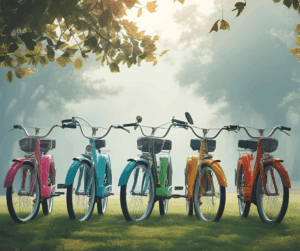Bike transportation is an essential consideration for urban cyclists who rely on public transit to extend their riding range, avoid inclement weather, or navigate areas with heavy traffic. Whether you’re commuting to work, heading to a scenic trail, or simply need to cover a long distance without exhausting yourself, knowing how to efficiently transport your bike on MRT (Mass Rapid Transit) and buses can make your journey seamless. However, each transit system has its own set of rules, space limitations, and etiquette expectations that cyclists must follow. This comprehensive guide will explore every aspect of bike transportation on public transport, from regulations and best practices to essential gear and troubleshooting common issues.
Understanding the Rules and Regulations for Bike Transportation
Before attempting to bring your bike onto any form of public transport, it’s crucial to research and adhere to local policies. Transit authorities implement specific rules to ensure safety, minimize disruptions, and maintain smooth operations for all passengers.
1. Transit System-Specific Policies
- Peak Hour Restrictions: Most cities prohibit full-sized bikes on MRT and buses during rush hours (typically 7–9 AM and 5–7 PM) to prevent overcrowding.
- Folding Bike Exemptions: Many systems allow folding bikes at all times, provided they are collapsed and stored in a carrying bag.
- Permits & Additional Fees: Some regions require cyclists to purchase a bike pass or pay an extra fare for bringing a non-folding bicycle on board.
2. Bike Type and Size Limitations
- Standard Bicycles: Often restricted to certain train cars or external bus racks.
- E-Bikes & Cargo Bikes: May face additional restrictions due to weight or battery concerns—always verify beforehand.
- Folding Bikes: The most versatile option, as they can be treated like regular luggage when properly stored.
3. Regional Variations For Bike Transportation
- Singapore (SMRT): Allows folding bikes at all times if bagged; non-folding bikes only on selected MRT lines during off-peak hours.
- New York City (MTA): Permits full-sized bikes on subways except during peak times; buses only accommodate folding bikes.
- London (TfL): Non-folding bikes are allowed on limited sections of the Underground and Overground, with restrictions during busy periods.
Always check your local transit authority’s official website for the most up-to-date bike transportation policies.
A Step-by-Step Guide for Bike Transportation on the MRT
Taking your bike on the MRT requires careful planning to avoid inconveniencing fellow passengers and ensure compliance with regulations.
1. Locate Designated Bike Areas
Many modern metro systems feature marked bicycle zones, usually at the ends of trains. These areas are equipped with straps or vertical stands to secure bikes during transit. If unsure, station staff can direct you to the appropriate car.
2. Preparing Your Bike for Boarding
- Folding Bikes: Collapse the frame, secure it with built-in locks or straps, and place it in a protective bag to prevent grease marks or scratches.
- Full-Sized Bikes: Remove any loose accessories (e.g., panniers, lights) and ensure tires are clean to avoid dirtying the train.
3. Boarding and Securing Your Bike
- Enter through the designated doors (often the first or last car).
- Use provided straps or bring your own bungee cords to prevent the bike from rolling.
- Stand near your bike to monitor it and adjust positioning if necessary.
4. Exiting the Train Smoothly
- Prepare to disembark one stop early to avoid rushing.
- Lift (don’t roll) your bike over gaps between the train and platform.
How to Transport Your Bike on Buses: A Detailed Breakdown
Buses present unique challenges due to limited interior space, but many are equipped with exterior racks to accommodate cyclists.
1. Using Front-Mounted Bike Racks
Most urban buses feature racks that hold 2–3 bikes. Here’s how to use them correctly:
- Signal the Driver: Approach the bus from the curb and make eye contact to indicate you’ll be loading a bike.
- Lower the Rack: Pull the handle to release the rack; it folds down easily.
- Load Your Bike: Place your bike into an empty slot, ensuring the front wheel faces the support arm.
- Secure the Clamp: Raise the locking mechanism over the front tire to hold the bike in place.
- Board the Bus: Sit near the front to keep an eye on your bike during the ride.
Pro Tip: Practice using the rack at a quiet stop to build confidence before attempting it during peak travel times.
2. Boarding with a Folding Bike
- Fold the bike completely before stepping onto the bus.
- Store it under a seat or in the luggage area to avoid blocking aisles.
3. Handling Rejections or Full Racks
- If the rack is full, ask the driver if you can stand with your bike inside (rarely permitted).
- Have a backup plan, such as a nearby bike-share station or a short ride to the next stop.
Essential Gear for Hassle-Free Bike Transportation
Investing in the right accessories can significantly improve your experience when combining cycling with public transit.
1. High-Quality Folding Bike Bags
- Protects your bike from scratches and keeps dirt contained.
- Makes it easier to carry and store in tight spaces.
2. Adjustable Bike Straps & Bungee Cords
- Prevents bikes from tipping over on trains or buses.
- Useful for securing bikes to poles or racks.
3. Compact Bike Locks
- A lightweight U-lock or cable lock deters theft if you need to leave your bike briefly.
4. Waterproof Bike Covers
- Shields your bike from rain and prevents moisture damage during transit.
Etiquette for Cyclists Using Public Transport
Respecting other passengers ensures that bike transportation remains a viable option for everyone.
Do’s
✔️ Fold your bike before boarding whenever possible.
✔️ Wipe down muddy or wet tires to keep floors clean.
✔️ Stand near your bike to monitor it and adjust as needed.
Don’ts
❌ Block doors, aisles, or priority seating areas.
❌ Take up extra seats with your bike or gear.
❌ Argue with transit staff—comply with their instructions.
Troubleshooting Common Bike Transport Challenges
Even with preparation, unexpected issues can arise. Here’s how to handle them:
1. Denied Boarding Due to Crowding
- Wait for the next train or bus with more space.
- Consider cycling part of the way and reboarding later.
2. Bike Rack Malfunctions
- Test the rack before the bus arrives to ensure it deploys correctly.
- If it’s broken, inform the driver and assess alternatives.
3. Theft Concerns
- Never leave your bike unattended on an external rack.
- Use a secondary lock if stopping at a transfer point.
Final Thoughts: Making Bike Transportation Work for You
Mastering bike transportation on public transit opens up new possibilities for commuting, touring, and exploration. By understanding the rules, investing in the right gear, and practicing considerate behavior, cyclists can seamlessly integrate bikes with MRT and bus systems. Whether you’re a daily commuter or a weekend adventurer, these strategies will help you navigate urban transit networks with confidence.
Key Takeaways:
- Always verify local bike transportation policies before traveling.
- Folding bikes offer the greatest flexibility on public transport.
- Bus bike racks are convenient but require practice to use efficiently.
- Good etiquette ensures a positive experience for all passengers.
With these insights, bike transportation on MRT and buses becomes a practical and stress-free component of your cycling lifestyle. Safe travels and happy riding!





